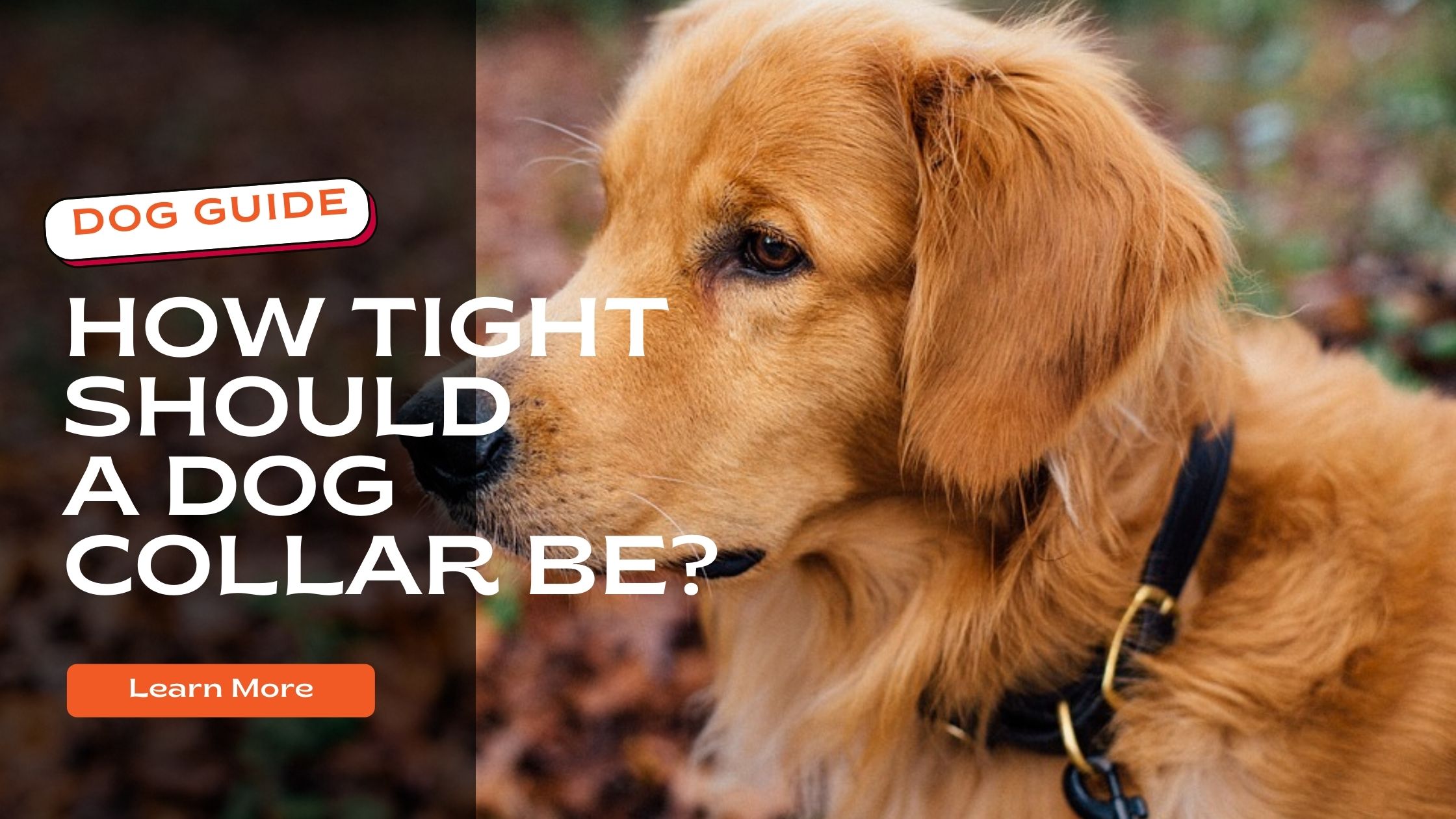Dogs are people, too. They like to look stylish, stay in shape, and smell nice. Sometimes they want to sleep on the bed with you, and sometimes they like to carry their keys—just like humans! Unfortunately, dogs’ preferences for comfy clothes or sturdy leashes don’t always consider comfort and safety.
The saying “dogs are best friends” is entirely accurate. But what if you’re hurting your furry friend by forcing them to wear dog collars that are too tight or too loose?
Why Does a Dog Need a Right Dog’s Collar?
A dog’s collar is an essential piece of equipment for your pup’s neck. A right fit will be a big part of their comfort and safety, which can’t always be taken at face value because some dogs are more sensitive than others to the tightness around their neck area, depending on size or breed.
Finding the Perfect Fit Dog Collars
Many dog owners aren’t aware of the properly fitting collar around a dog’s neck, resulting in behavioural problems such as aggression or anxiety issues when wearing a lead. Likewise, if your pup has delicate skin or is prone to allergic reactions (or if he isn’t a fan of human accessories), choosing an inappropriate loose collar could make for an uncomfortable experience every time you put it on him, so you must know your How tight should a dog collar be.
How Tight Should a Dog Collar be?
Dog collars come in various styles, colors, and materials, but be sure that it fits and is secure when selecting one for your dog.
It is important to choose a collar that fits properly at the neck but isn’t too tight.
If you don’t have a cloth tape measure, you can use a piece of string or ribbon to measure your dog’s neck circumference with a standard ruler. Depending on your dog’s size, you will need to add between one and three inches (depending on their length) to this measurement to determine the correct length of their collar.
A dog’s collar should be as wide as it is long. While a collar that’s too narrow for your dog may not be comfortable when walking, a too wide collar can rub and cause discomfort. The collars of bigger, stronger, and pulling dogs should be wider.
As a general rule, two fingers should easily slide under the dog’s collar once the collar is fastened. A thick collar should feel cozy, but not tight when you slide your fingers across it. If your dog’s collar can be slid off, he will end up slipping his collar.
As soon as you find the appropriate collar size for your dog and know how tight a dog collar should be, you need to make sure it’s still in good repair and fits correctly.
Two Finger Rule
The “two finger rule” is a simple method of determining whether a collar fits well.
Taking your pointer and middle fingers (two fingers) and sliding them between the collar and your canine’s neck is one way to determine whether a collar fits properly. The dog harness fits well when your fingers easily slide under it but also feel snug.
The Right Collar for Every Dog’s Neck
Selecting the right collar is about more than simply choosing something cute. The most important thing you should consider when buying a dog collar is what purpose it will serve. While there are many different collars available, there are three basic categories: halsbands (also called halter or head collars), buckle collars and martingales (or limited-slip collars). Each type has its advantages and disadvantages, so let’s take a closer look at their features.
Measure your Dog’s Neck
As you might imagine, selecting a dog’s collar for your furry friend depends largely on his size. If you’re not sure if a collar will fit him, try it out on yourself first before buying it—your local pet store may let you do this so that you can see how it works with your dog instead of just an inanimate dummy! Here are some things to keep in mind as you determine which type of collar will be best for your pup.
Large Breed Dogs: Many dog owners focus on the size of their dog’s paws and muzzle, but often they neglect to consider how big his neck is! Take a look at your dog’s head—do you see any white fur behind his ears? If so (and if he isn’t wearing a sweater), he is probably not part Husky.
Most large breeds have necks that are approximately as wide around as their heads are long, which means owning limited-slip collars for them could be detrimental because these devices can pinch or make it difficult for them to breathe. A good alternative would be a halsband-type collar with adjustable loops and nonslip material between the two rings located around the nose and ears.
Small-breed dogs: Smaller dogs can sometimes fit into collars designed for larger breeds. If you have a smaller dog, make sure his collar isn’t too large and that the metal hardware doesn’t rub against his neck or press uncomfortably against his throat when he pulls on the leash. You might want to invest in a martingale style of collar instead, which won’t give him such a choking sensation if he does pull on it.
Sizing for Perfect Fitting Collar
To measure your dog’s neck accurately, you must use a cloth soft measuring tape. You should always choose an appropriate collar for your dog’s neck. If you choose a tight collar, it will not provide a comfortable fit for the dog. You should measure the neck size of the dog first. The collar size is also important since it will determine how the collar fits. It is more comfortable to wear a collar with more snaps on it.
How to simply adjust a dog collar for a proper fit
To ensure the dog collar sizes properly, you should check the dog’s neck. If you inspect your dog’s neck, the collar should not be too snug, but it should not also be loose. In addition, it shouldn’t have protruding buckle parts and must be broad enough to spread evenly in all directions.
There must be enough space between the shoulder and the dog’s body so that the collar can slip through. Several pet collars have an adjustable length that can be simply adjusted by an inch.
You should not wear a collar that is too loose. A leash can be attached to the dog accessory once the neck has been adjusted. It should still be tightened slightly so that the dog won’t touch its neck while wearing the leash. Leads shouldn’t be restrictive either.
How to test the fit of your dog collar
Always ensure the collar fits correctly when walking your dog. You will likely end up with a loose collar if you use a training collar with a steep learning curve. Make sure you test the collar on your dog before buying it. To determine whether the collar fits properly, it is best to remove the collar.
Where To Use:
Tie-outs are used in many different ways, by many other people, and for many various reasons. However, some of the most common uses for tie-outs include:
Freeing up your hands: A simple pair of dog leashes probably won’t cut it if you have a particularly energetic puppy! So instead, Tie-outs allow you to put your dog outside while taking care of other tasks or playing with smaller dogs inside.
In addition, your canine companion will be able to socialize without having to constantly listen for your beckoning call because he’ll know you’re nearby, guarding him against any danger that might present itself!
Safety during walks: Even though they can’t walk dogs from place to place, tie-outs can keep your puppy safe when you walk him from point A to point B.
If he’s a particularly strong-willed dog whose leash pulling is causing you to trip, choke, or feel generally unsafe while walking with him, consider using one of these instead! While some owners need them for their pets’ good after being trained properly on the lead (instead of letting them trot happily along like show dogs), most folks use it as a safety measure because they don’t have more control over their pup.
Dog care: If you’re worried about leaving your ill or injured dog alone at home while you go out (especially if you live in an area with lots of crime), consider using a tie-out to keep him busy (and safe) while you’re gone.
Simply hook one end up to the side of his dog house, and let him enjoy the fresh air and freedom from being cooped up all day!
Combination: Most people use both leashes and tie-outs in combination together, including me. This is because they can be used interchangeably depending on your dog’s temperament—especially if he gets nervous or has skin irritation when wearing a leash.
Hanging out with me during walks is just fine for my pup as I’m always nearby to soothe him if need be; however, many other pups prefer not only walking alone but also having their personal space even when they’re tied to me!
Step By Step – How To Put Your Dog On A Leash And Tie-Out
- First of all, make sure that your dog is on his lead (whether he’s using a collar or harness), and then clip it onto the tie out. You can put the lead through any part of the tie-out to properly secure it, but most owners prefer something close to the ground so that they don’t have to worry about tripping over anything when trying to catch their pet. Make sure that you’re not clipping your pup into the middle of a pole if you’re dealing with one of these!
- Next, take your dog outside (or bring him down from upstairs if you don’t have a porch). While I’ve already mentioned this briefly above, keep in mind that you’ll be responsible for keeping your pup in the yard or at lead within reach while he’s on a tie-out. If you need to keep him with you, then feel free to put his regular collar and leash on; but otherwise, don’t worry about it as long as he’s secured in place!
- Take note of where your pet is going while on his tie out. As I’ve already mentioned before, some dogs like to nap under trees or by doors; other dogs prefer to venture off towards the refrigerator or any other household item, and doggies can even chase one another around (if they have playmates!) As soon as your dog starts doing something silly, call him back immediately so that he doesn’t get lost and you’re not in trouble with the neighbours.
- From time to time, make sure that your pup is properly hydrated, fed, loved upon, etc. while out on his tie-out; this will ensure that you don’t have any issues or injuries from happening to him if your attention gets split or something else catches your eye for a minute. If you’re watching TV during this time (or are otherwise occupied), then consider putting some music on so that it’s easier to pay attention to what he’s doing! Also, remember that you can always bath him as soon as you get home from work if he has been dirty outside all day long; just make sure that you don’t soak him too much so that his skin doesn’t become irritated
Important Links


